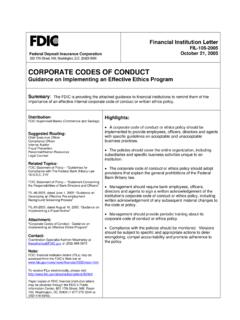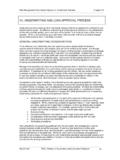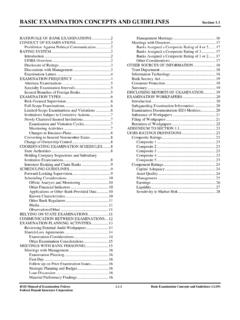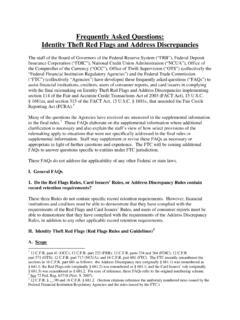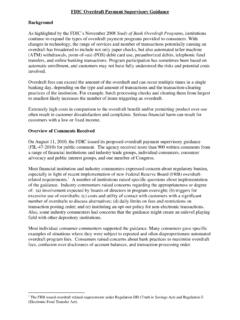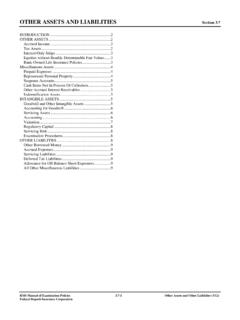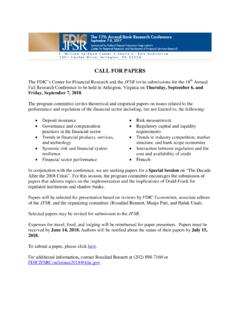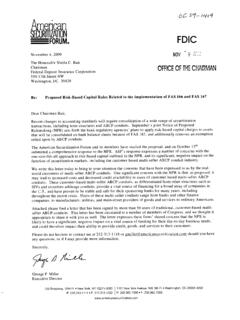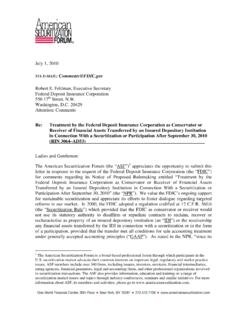Transcription of V. Compliance Lending —SAFE Act
1 V. Compliance Lending SAFE Act FDIC Consumer Compliance Examination Manual September 2015 V Secure and Fair Enforcement for Mortgage Licensing Act Examination Procedures for Covered Financial Institutions Introduction The Secure and Fair Enforcement for Mortgage Licensing Act of 20081 (SAFE Act) was enacted on July 30, 2008, and mandates a nationwide licensing and registration system for residential mortgage loan originators (MLOs).2 The SAFE Act prohibits individuals from engaging in the business of residential mortgage loan origination without first obtaining and maintaining annually: For individuals employed by a covered financial institution, registration as a mortgage loan originator and a unique identifier (federal registration); or For all other individuals, a state license and registration as a mortgage loan originator, and a unique identifier (state licensing/registration).
2 3 The SAFE Act requires that federal registration and state licensing/registration be accomplished through the same online registration system, the Nationwide Mortgage Licensing System and Registry (Registry). The objectives of the SAFE Act include aggregating and improving the flow of information to and between regulators; providing increased accountability and tracking of MLOs; enhancing consumer protections; supporting anti-fraud measures; and providing consumers with easily accessible information at no charge regarding the employment history of, and publicly adjudicated disciplinary and enforcement actions against On July 28, 2010, the OCC, Board, FDIC, OTS, NCUA, and FCA (collectively the Agencies) published substantively similar regulations implementing the SAFE Act federal 1 12 USC 5101-5116, Title V of the Housing and Economic Recovery Act of 2008 (Pub.)
3 L. 110 289, 122 Stat. 2654), as amended by Title X of the Dodd-Frank Wall Street Reform and Consumer Protection Act (Dodd-Frank Act) (Pub. L. No. 111-203, 124 Stat. 1376). 2 More specifically, the SAFE Act required the Office of the Comptroller of the Currency (OCC), Board of Governors of the Federal Reserve System (Board), Federal Deposit Insurance Corporation (FDIC), and National Credit Union Administration (NCUA), with the Farm Credit Administration (FCA), and through the Federal Financial Institutions Examination Council (FFIEC), to develop and maintain a federal system for registering MLOs employed by covered financial institutions. 3 The SAFE Act authorized the Department of Housing and Urban Development (HUD) to monitor and enforce states Compliance with the statute s requirements for state licensing and registration. On June 30, 2011, HUD published a final rule setting minimum standards for state licensing and registration.
4 76 Fed. Reg. 38464 (June 30, 2011). 4 12 USC 5101. registration requirements for covered institutions and their MLO employees (SAFE Act regulation).5 On July 21, 2011, Title X of the Dodd-Frank Act transferred rulemaking authority for the SAFE Act to the Consumer Financial Protection Bureau (CFPB).6 The CFPB published an interim final rule, which recodified the Agencies SAFE Act regulations as a single regulation, Regulation G, at 12 CFR Part 1007, effective December 30, These examination procedures lay out the background and requirements of the SAFE Act and the SAFE Act regulation concerning federal registration. Definitions Annual renewal period means November 1st through December 31st of each year. Administrative or clerical tasks means the receipt, collection, and distribution of information common for the processing or underwriting of a loan in the residential mortgage industry and communication with a consumer to obtain information necessary for the processing or underwriting of a residential mortgage loan.
5 Covered financial institution means any national bank , Federal branch and agency of a foreign bank , member bank , insured state nonmember bank (including state-licensed insured branches of foreign banks), savings association, or certain of their subsidiaries; branch or agency of a foreign bank or commercial Lending company owned or controlled by a foreign bank ; Farm Credit System institution; or federally insured credit union, including certain non-federally insured credit 5 75 Fed. Reg. 44656 (July 28, 2010). The interagency Federal Register notice may be found at See also the revised Federal Register Preamble (Aug. 23, 2010), available at (revising footnote numbering from the original release). 6 On July 21, 2011, pursuant to the Dodd-Frank Act the CFPB assumed: (1) responsibility for developing and maintaining the federal registration system (including rulemaking authority); (2) supervisory and enforcement authority for SAFE Act Compliance for entities under the CFPB s jurisdiction; and (3) HUD s SAFE Act authority to oversee state Compliance with SAFE Act requirements that had previously been under HUD s authority.
6 Refer to Dodd-Frank Act Sections 1025, 1061 and 1100. In addition, the Dodd-Frank Act merged functions of the OTS into the OCC, FDIC, and Board. 7 See 76 Fed. Reg. 78483 (Dec. 19, 2011), available at In the preamble to the interim final rule, the CFPB stated that [t]he interim final rule substantially duplicates the Federal registry agencies largely identical coordinated rules as the Bureau s new Regulation G, 12 CFR part 1007, making only certain nonsubstantive, technical, formatting, and stylistic changes. 8 12 CFR Secs. (c), V. Compliance Lending SAFE Act V FDIC Consumer Compliance Examination Manual September 2015 Employee is not defined in the SAFE Act or SAFE Act regulation. However, the original regulation s preamble explains that the meaning of employee under the SAFE Act regulation is consistent with the common law right-to -control test.
7 For example, the results of this test generally determine whether an institution files an Internal Revenue Service Form W-2 or Form 1099 for an Mortgage loan originator or MLO means an individual who: (1) takes a residential mortgage loan application and (2) offers or negotiates terms of a residential mortgage loan for compensation or The term mortgage loan originator does not include: An individual who performs purely administrative or clerical tasks on behalf of an individual who is an MLO; An individual who only performs real estate brokerage activities (as defined in 12 USC Section 5102(3)(D)) and is licensed or registered as a real estate broker in accordance with applicable state law, unless the individual is compensated by a lender, a mortgage broker, or other MLO or by any agent of such lender, mortgage broker, or other MLO, and meets the MLO definition; or An individual or entity solely involved in extensions of credit related to timeshare plans, as that term is defined in 11 USC Section 101(53D).
8 Appendix A to the SAFE Act regulation provides examples of activities of taking a loan application, and offering or negotiating loan terms, that fall within or outside of the definition of MLO for federal registration purposes. Registry means the Nationwide Mortgage Licensing System and Registry, or NMLS, developed and maintained by the Conference of State bank Supervisors and the American Association of Residential Mortgage Regulators for the state licensing and registration of state-licensed MLOs, and through which federal MLO registrations must be Registered mortgage loan originator or registrant means any individual who: (1) meets the MLO definition; (2) is an employee of a covered financial institution; (3) is registered 9 See 75 Fed. Reg. at 44664 for a discussion of the meaning of employee as used in the original SAFE Act regulation.
9 10 By contrast, the Model State Law defines an MLO for state licensing and registration purposes as an individual who takes a residential mortgage loan application or offers or negotiates terms for compensation or gain. See, , the Model State Law at: 11 See the Nationwide Mortgage and Licensing System and Registry Web site at: System information on federal registration can be found under the Federal Registration tab at that site. pursuant to the regulation with the Registry; and (4) maintains a unique identifier through the Registry. Residential mortgage loan means any loan primarily for personal, family, or household use that is secured by a mortgage, deed of trust, or other equivalent consensual security interest on a dwelling (as defined in Section 103(v) of the Truth in Lending Act, 15 USC Section 1602(v)) or residential real estate upon which is constructed or intended to be constructed a dwelling (including manufactured homes) and includes refinancings, reverse mortgages, home equity lines of credit, and other first and additional lien loans.
10 Unique identifier means a number or other identifier that: (1) permanently identifies a registered MLO; (2) is assigned by protocols established by the Registry and the Bureau to facilitate electronic tracking of MLOs, as well as uniform identification of, and public access to, the employment history of and the publicly adjudicated disciplinary and enforcement actions against MLOs; and (3) must not be used for purposes other than those set forth under the SAFE Act. De Minimis Exception The SAFE Act regulation provides an exception to the MLO registration requirements for any employee of a covered financial institution who has never been registered or licensed through the Registry as an MLO if during the past 12 months the employee acted as an MLO for five or fewer residential mortgage loans. When an institution relies on the de minimis exception in lieu of registration, the MLO employee must register prior to originating the sixth residential mortgage loan within the past 12 months.
